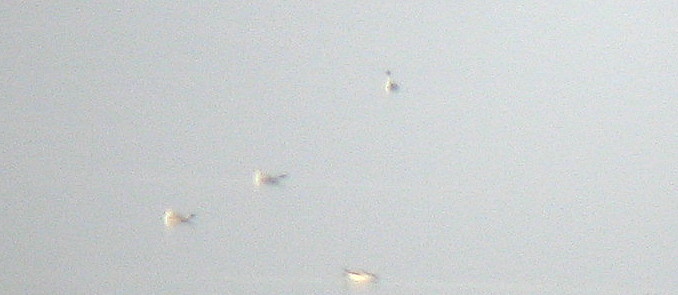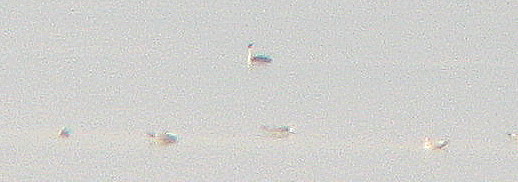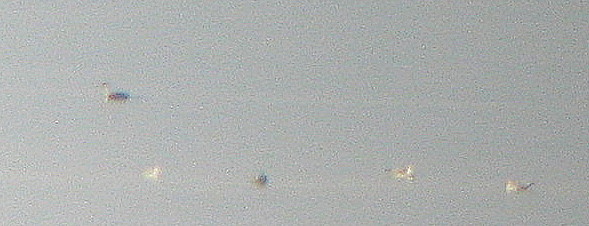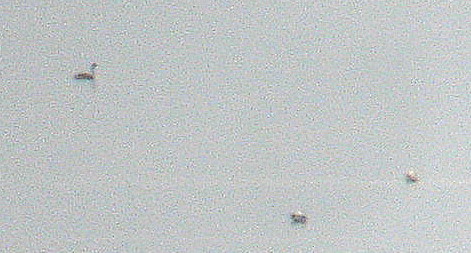|






Several birders wanted me to show them Canvasbacks and whatever else I could
find. So, I agreed to a trip to Lake
Seminole and WFG, 12/06/06. Darlene Moore
and I hit Lake Seminole in the morning, and we quickly found CANVASBACKS
eventually
numbering in the hundreds. I counted seventeen species of duck
there. The best bird was a RED-NECKED GREBE that we got
to watch for a while.
It was near the dam and swam over much of the lake. Much of the time in GA but
also drifting
into Florida waters. Pretty interesting since it is listed as
quite rare in GA and accidental with only a few records
for the coastal plain
of Georgia. Also, I remember that it used to be unverified for Florida. I
assume that has changed
over the last five or so years, but still very rare for
Florida. Also, I was pleased to see at least two EARED GREBES
at this location.
It is listed as accidental outside the piedmont. By the way there were also
Horned Grebes and many
Pied-billed Grebes, resulting
in a Five Grebe Day before the day was out!
Highlights for Lake Seminole, GA:
Red-necked Grebe (1)
Eared Grebe (2)
Red-throated
Loon (1)
17 Species of Duck:
Canvasback (400+)
Redhead (about 30)
Greater
Scaup (about 20)
Northern Pintail (2)
Red-breasted Merganser (4)
Tree Swallow (30)
Little Blue Heron (1)
Black-crowned Night-heron (10)
We leisurely made our way up to Lake Walter F. George
Dam. After about ten
minutes of scanning I found a WESTERN GREBE. It was out a ways on the GA side,
but Darlene Moore's
Leica Televid 60x scope brought it in surprisingly well. We
watched it for a while and eventually it moved in closer.
We were able to
verify all field marks for identification: very large for a grebe; long,
swan-like neck, wing pattern
of outstretched wing was dark on top with faint
white stripe down the center; white foreneck and black nape and cap; black
cap
dips below eye; dark body sat low in the water; bill was long, thin, and dull
yellow. The bird was first on the
GA/AL line. Then it moved into GA waters for
a while and then back into Alabama waters. The bird was seen and confirmed
by
four other birders besides Darlene and myself. They all had their own scopes,
which is pretty much a necessity
at this location. The bird continued pretty
much in the same spot when we left in the
evening.
Highlights
from Lake Walter F. George, GA:
Western Grebe (1)
Canvasback (about 10)
Redhead (about 10)
Greater Scaup (about 5)
Sandhill Cranes (4)
The Western Grebe was out a ways and towards the middle of the lake as viewed
from the dam at
Lake Walter F. George. If was mainly in GA waters but did swim
into AL waters at times. If the bird tucks its head in,
it can be quite
difficult to see even through a scope.
We had almost perfect viewing conditions. If windy,
scanning from the dam can
be a miserable experience and not very fruitful. It might be best to scan from
the AL side
if the sun is going down so that the light is not against you.
Thanks to Darlene Moore for her help and those
who also came shortly after to
see the bird and thanks to Tracy for posting the info for me.
If you look
for the Western Grebe, note that I have also recently had Pacific
Loon, Ross's Goose, Lesser Black-backed Gull, Black
Scoter, and Long-tailed
Duck at this location. Also, I?ve had Ross's Goose, Greater White-fronted
Geese, Red-throated
Loons, Red-necked Grebe, and other things somewhat near
this location recently. The Pacific Loon was a couple weeks ago
but remained at
least a few days for other observers to see it. These birds may still be
present here. (Michael and
I found a Red-necked Grebe at Lake WFG earlier this
year.) I didn't spend much time looking at the other birds yesterday,
since I
was concentrating on the grebe, so some of the aforementioned birds may be
continuing.
There
are basically two reports/records for Western Grebe in Georgia. The
first was in 1979 when one was found at Peachtree
City Lake in Fayette County
by Richard Beohm, Rose Beohm, Michael Beohm, and myself. We saw the bird at
very close
range through binoculars, took clear detailed notes of it, and were
able to separate it from Clarke's. The second record
was 1997 St. Simons Island
where a bird was found injured and died.
Eric Beohm
|

